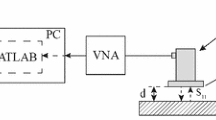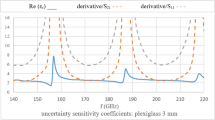Abstract
Results of the numerical experiment are presented, which allow considerably extending the range of the waveguide method capabilities in determination of the complex permittivity of materials. Two main methodological errors are estimated, which affect the measurement accuracy and are related to errors in determination of the sample boundary positions in the measuring section and to presence of an air gap between the sample and the wide wall of the waveguide. Calculations are performed in the centimeter and millimeter ranges for materials with a large real component of the permittivity (ε1 ⩾ 25) and tangents of the dielectric loss angle tan δε varying between 0.1 and 0.2. Ways of decreasing the errors are proposed. To decrease the measurement error caused by the inaccurate positioning of the sample boundaries, it is proposed to use measuring section-flanges with the length equal to the length of the sample. To decrease the error caused by the air gap between the sample and the wide wall of the waveguide, it is proposed to fill the gap with a nonconducting paste composed of finely dispersed copper powder mixed with petrolatum. The centimeter-range experiment on determination of the complex permittivity of high-ohmic silicon shows an appreciable decrease in the measurement error when the air gap is filled with the above paste. The presented method also allows the complex permeability of a material to be determined. The real component μ1 of the complex permeability of silicon as a dielectric is unity. This is experimentally confirmed.
Similar content being viewed by others
References
A.A. Brandt, Investigation of Dielectrics at Microwave Frequencies (Fizmatgiz, Moscow, 1963) [in Russian].
L.F. Chen, C.K. Ong, C.P. Neo, V, V, Varadan, and V.K. Varadan, Microwave Electronics: Measurement and Materials Characterization (Wiley, 2004) [DOI: https://doi.org/10.1002/0470020466].
M.P. Parkhomenko, D.S. Kalenov, N.A. Fedoseev, I.S. Eremin, V.M. Kolesnikova, and D.A. Kovtykov, “The Improved Resonator Method for Measuring the Complex Permittivity of Materials,” J. Commun. Tech. Electron. 62(7), 759 (2017) [DOI: https://doi.org/10.1134/S106422691706016X].
M.P. Parkhomenko, D.S. Kalenov, N.A. Fedoseev, I.S. Eremin, V.G. Ralchenko, A.P. Bolshakov, E.E. Ashkinazi, A.F. Popovich, V.K. Balla, and A.K. Mallik, “Measurement of the Complex Permittivity of Polycrystalline Diamond by the Resonator Method in the Millimeter Range,” Phys. Wave Phenom. 23(3), 202 (2015) [DOI: https://doi.org/10.3103/S1541308X15030073].
A.M. Nicolson and G.F. Ross, “Measurement of the Intrinsic Properties of Materials by Time-Domain Techniques,” IEEE Trans. Meas. 19(4), 377 (1970) [DOI: https://doi.org/10.1109/TIM.1970.4313932].
W.B. Weir, “Automatic Measurement of Complex Dielectric Constant and Permeability at Microwave Frequencies,” Proc. IEEE. 62(1), 33 (1974) [DOI: https://doi.org/10.1109/PROC.1974.9382].
M.P. Parkhomenko, S.V. Von Gratovski, and S.V. Savel’ev, “Analysis of Dielectric Properties of Blood and Development of a Resonator Method for Noninvasive Measuring of Glucose Content in Blood,” J. Commun. Tech. Electron. 62(3), 267 (2017) [DOI: https://doi.org/10.1134/S1064226917030159].
M.P. Parkhomenko, D.S. Kalenov, I.S. Eremin, N.A. Fedoseev, V.M. Kolesnikova, and Yu.L. Barinov, “Waveguide Method of Measurements of Electromagetic Parameters of Materials in Microwave Range and Estimation of Measurement Error,” Zh. Radioelectron. No. 9 (2018) [DOI: https://doi.org/10.30898/1684-1719.2018.9.6] [in Russian].
I.V. Lebedev, Microwave Techniques and Instruments, Vol. 1 (Vysshaya Shkola, Moscow, 1970) [in Russian].
B.M. Garin, A.N. Kopnin, M.P. Parkhomenko, A.A. Izyneev, and V.A. Sablikov, “Method for Producing Silicon with Extremely Low Millimeter and Submillimeter Range Losses,” Tech. Phys. Lett. 20(21), 878 (1994).
Funding
The work was supported within the State Assignment on Topic 0030-2019-0014.
Author information
Authors and Affiliations
Corresponding authors
About this article
Cite this article
Parkhomenko, M.P., Kalenov, D.S., Eremin, I.S. et al. Usage and Experimental Tests of the Modified Waveguide Method for Measurement of the Complex Permittivity and Permeability of Materials. Phys. Wave Phen. 27, 299–306 (2019). https://doi.org/10.3103/S1541308X19040101
Received:
Revised:
Accepted:
Published:
Issue Date:
DOI: https://doi.org/10.3103/S1541308X19040101




